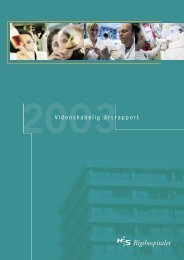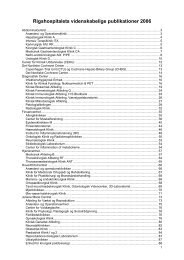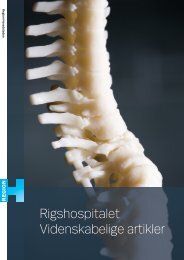View - CTU
View - CTU
View - CTU
You also want an ePaper? Increase the reach of your titles
YUMPU automatically turns print PDFs into web optimized ePapers that Google loves.
ita from 1997 and 2003<br />
tas 6.5% for the total pool<br />
1tal service provided, and<br />
25-year period could not<br />
fil/ appears to be the main<br />
;trategy<br />
leep caries in adults has<br />
·e trial the strength of the<br />
usion criteria. The caries<br />
s were found between all<br />
he follow-up radiographs.<br />
0.67). Moreover, the two<br />
l sequence and allocation<br />
J exposures between the<br />
ssion rates of the caries<br />
j that proper depths had<br />
could be differences in<br />
was 74.1% versus 62.4% in the direct complete excavation group (Table 2). The<br />
biological rationale for this difference could be that the first phase of stepwise<br />
excavation inactivates caries progression. The caries dentin becomes darker, harder<br />
and drier (Massler 1978, Bj0rndal et al.1997, Maltz et al. 2002, Kidd et al. 2008,<br />
Orhan et al. 2008), which makes it easier to remove without exposing the pulp at the<br />
final excavation. It has also been reported that a more dramatic reduction in the<br />
cultivable microflora is noted during stepwise excavation as compared with a direct<br />
complete excavation procedure (Orhan et al. 2008), which may provide some<br />
explanation for the significant difference found in the long-term outcome.<br />
It was expected that the partial pulpotomy procedure in the pulp capping trial had<br />
increased the potential of healing, as observed in young permanent teeth (Mejare &<br />
Cvek 1993, Qudeimat et al. 2007). However, the relatively small number of pulp<br />
exposures makes the confidence intervals wide and definite conclusions concerning<br />
choice of capping procedure could not be drawn from the pulp capping trial (Study<br />
Ill). In this trial the treatment of the cariously exposed adult pulp seemed to be a<br />
greater problem than expected. Irrespective of the capping method the majority of<br />
capped teeth failed (due to pain) before the follow-up examination. At follow-up<br />
32.8% of the capped teeth were successful (pulp vitality without apical radiolucency),<br />
confirming recent findings by Al-Hiyasat et al. (2006), where direct capping with<br />
calcium hydroxide of caries exposures was classified as successful in 33% after a 3-<br />
year period. It has been argued that pulp capping with Mineral Trioxide Aggregate<br />
(MTA) may significantly increase the healing rate, however, in a retrospective<br />
analysis of carious pulp exposures in adults treated with MTA, the pulp survival<br />
proportion was only 56.2% after 2 years (Miles et al. 2010).<br />
vation approach versus a<br />
exposures significantly. At<br />
fference between the two<br />
pulps with sustained pulp<br />
3tion group the proportion<br />
When assessing both trials together (Study Ill) using the primary outcome measure<br />
of sustained pulp vitality without apical radiolucency, no significant difference in<br />
success rate could be found between the stepwise excavation group versus the<br />
direct complete excavation group as a whole (Table 3).<br />
However, investigation of excavation approaches avoiding pulp exposure merits<br />
further study, when the markedly different outcome between teeth with unexposed<br />
37








